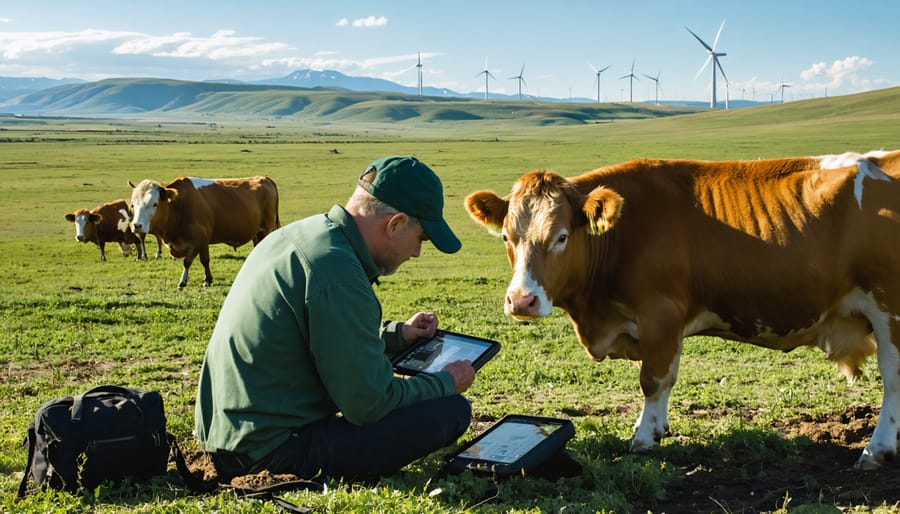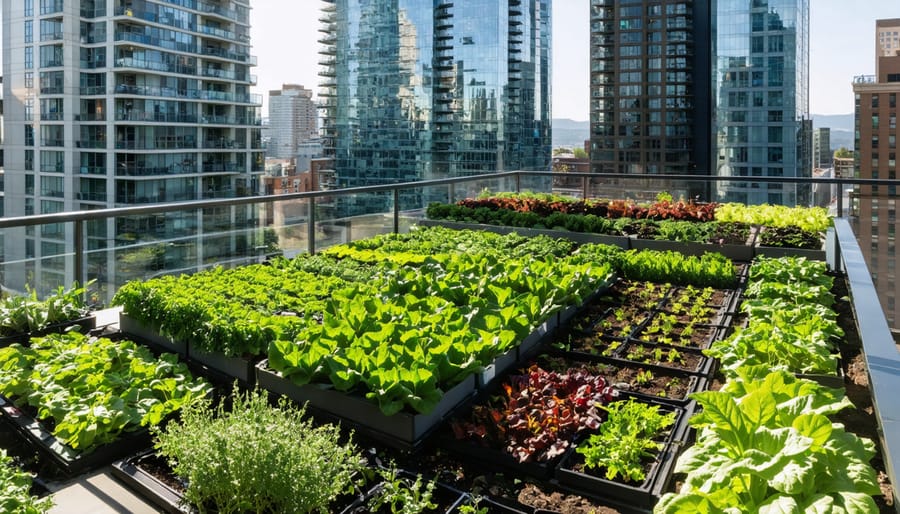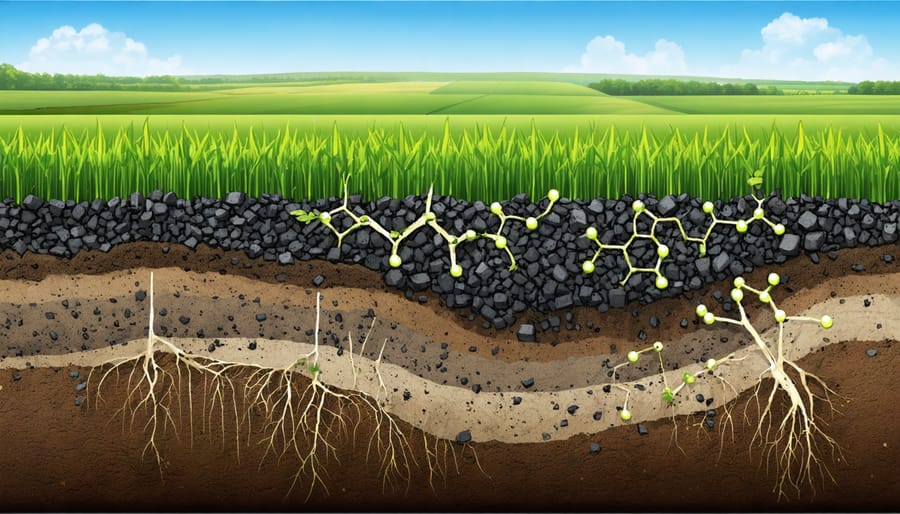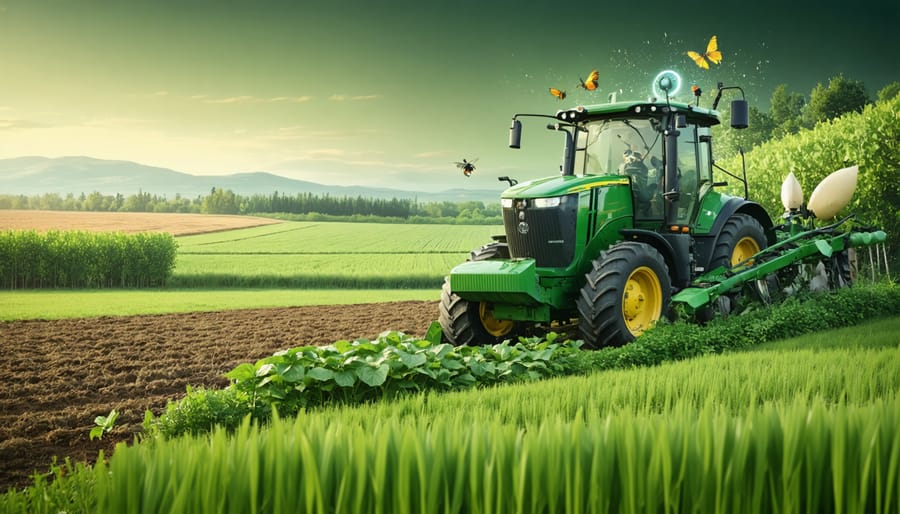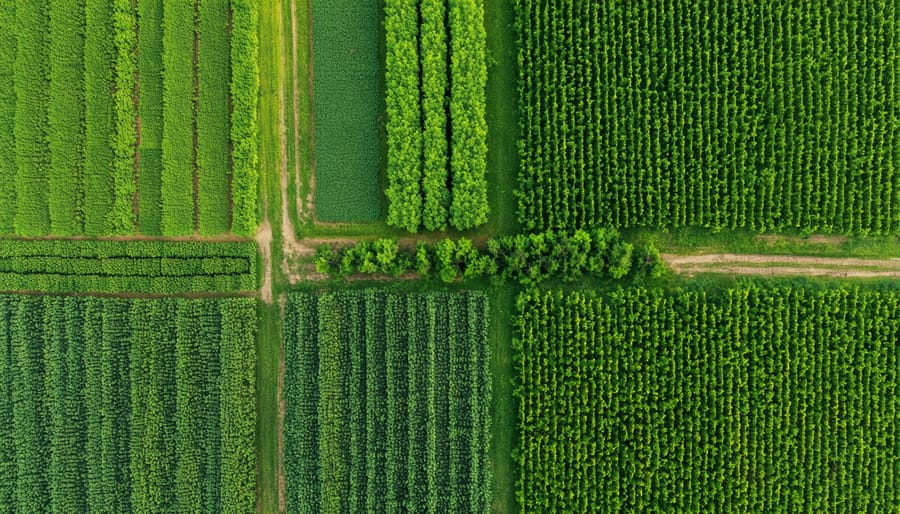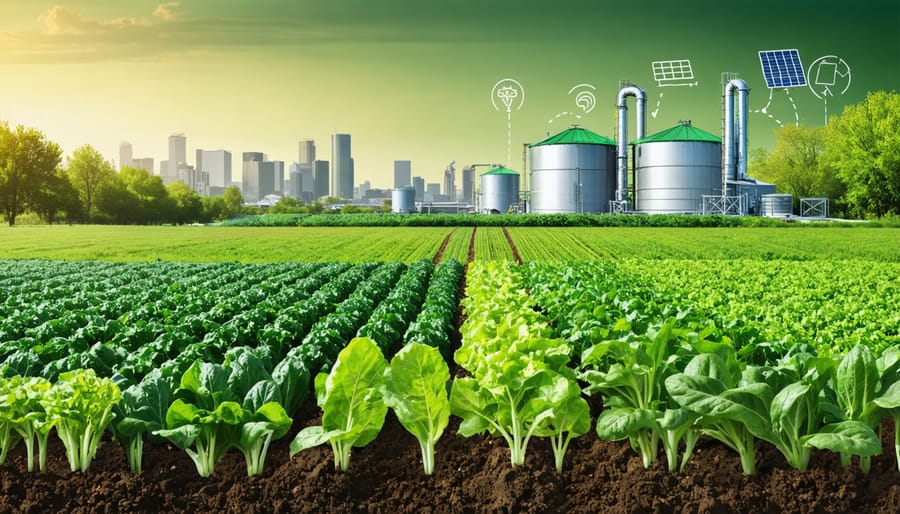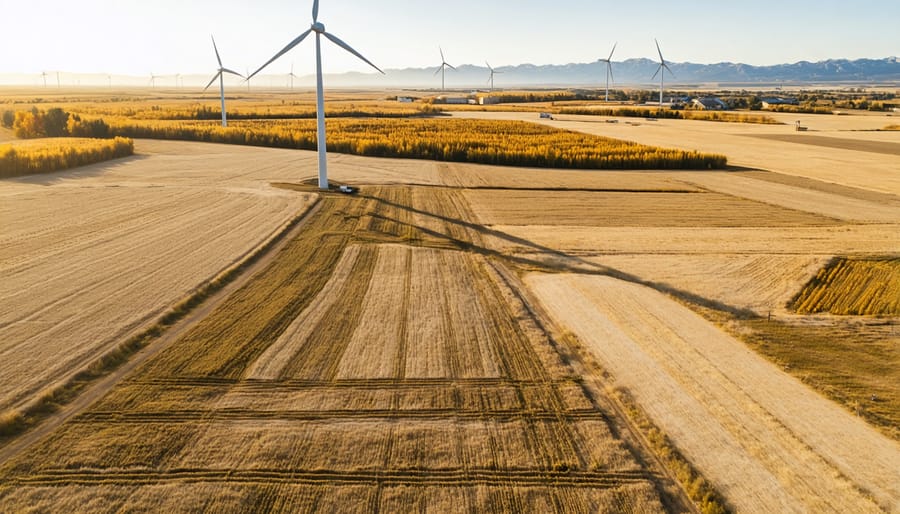Reducing livestock emissions demands immediate action from Canadian farmers as our agricultural sector faces mounting pressure to address climate change impacts. Recent data from Agriculture and Agri-Food Canada reveals that livestock operations contribute 33% of our agricultural greenhouse gas emissions, primarily through methane from cattle and manure management. However, through sustainable livestock management practices, Alberta farmers are already demonstrating that profitability and environmental stewardship can work hand in hand.
Leading Alberta beef producers have cut their emissions by up to 40% through strategic feed optimization, rotational grazing, and improved manure handling systems. These practical solutions not only reduce methane output but also enhance soil health and animal productivity. With carbon pricing and environmental regulations evolving, addressing livestock emissions isn’t just an environmental imperative—it’s becoming a critical business decision for Canadian farmers looking to maintain their competitive edge in the global market.
Our agricultural community stands at a pivotal moment where the choices we make today will shape the future of farming in Canada. By implementing proven emission reduction strategies, we can protect both our environment and our agricultural heritage while setting new standards for sustainable livestock production.
Understanding Your Farm’s Emission Profile
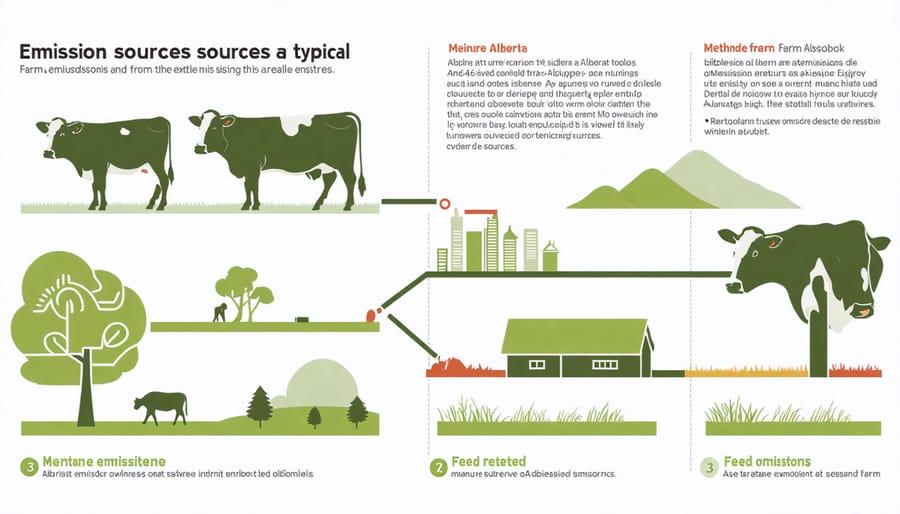
Key Emission Sources in Alberta Livestock Operations
Alberta’s livestock operations contribute to greenhouse gas emissions through three main sources, each tied to specific farming practices. According to recent provincial data, enteric fermentation from cattle digestion represents the largest methane source, accounting for approximately 45% of livestock-related emissions. This natural process varies significantly based on feed quality and herd management approaches used in sustainable farming practices in Alberta.
Manure management systems contribute the second-largest share, producing both methane and nitrous oxide emissions. Open storage systems typical in our region generate about 30% of total livestock emissions, while pasture-deposited manure accounts for roughly 15%. The remaining emissions come from on-farm energy use, including fuel for feed processing and barn climate control, producing primarily carbon dioxide.
Local studies show that emission levels vary seasonally, with higher methane production during warmer months and increased energy-related emissions during our cold winters. Understanding these patterns helps Alberta farmers implement targeted reduction strategies while maintaining productive operations.
Measuring Your Farm’s Carbon Footprint
Several user-friendly tools are available to help Canadian livestock farmers measure their operation’s carbon footprint. The Holos software, developed by Agriculture and Agri-Food Canada, is specifically designed for Canadian farming conditions and provides detailed emissions calculations based on your farm’s unique characteristics.
To get started, gather key data points including:
– Herd size and composition
– Feed types and quantities
– Manure management practices
– Energy consumption records
– Land use details
– Fertilizer application rates
The Alberta Carbon Offset Registry offers additional resources and protocols for measuring emissions. Many regional agricultural extension offices provide free support in conducting initial assessments and interpreting results.
Consider joining local farmer-led initiatives like the Canadian Roundtable for Sustainable Beef’s emissions tracking program. These community efforts often provide peer support and shared learning opportunities while collecting valuable data.
Remember that establishing your baseline emissions is the first step toward improvement. Regular monitoring helps identify effective reduction strategies and can highlight unexpected opportunities for both environmental and economic benefits.
Proven Emission Reduction Strategies
Feed Management Solutions
Feed management plays a crucial role in reducing greenhouse gas emissions from livestock operations. Here in Alberta, farmers are discovering that strategic dietary adjustments can significantly decrease methane production while maintaining animal health and productivity.
Organic feed options like high-quality legumes and carefully selected forage materials can improve digestibility and reduce enteric fermentation. Many Alberta farmers have found success with alfalfa-grass mixtures, which provide excellent nutrition while promoting efficient digestion. These feeds typically result in 15-20% lower methane emissions compared to conventional feed options.
Adding natural supplements such as seaweed derivatives has shown promising results in recent Canadian trials, with some farmers reporting methane reductions of up to 30%. Local feed specialists recommend incorporating these supplements gradually and monitoring animal response.
Precision feeding practices also make a significant difference. By matching feed quantities and compositions to specific growth stages and production needs, farmers can minimize waste while optimizing nutrition. Several Alberta dairy operations have implemented automated feeding systems that adjust rations throughout the day, resulting in both reduced emissions and improved feed efficiency.
Working with certified animal nutritionists to develop customized feed programs has helped many local farmers achieve their emission reduction goals while maintaining or even improving production levels. Regular feed analysis and adjustment of rations based on seasonal variations ensures consistent results throughout the year.
Grazing and Pasture Optimization
Optimizing grazing practices is one of the most effective natural climate solutions available to Canadian livestock farmers. Through strategic rotational grazing, producers can significantly enhance soil carbon sequestration while improving pasture productivity.
In Alberta, successful farmers are implementing adaptive multi-paddock grazing systems, where livestock are moved frequently between smaller paddocks. This approach allows grass to recover fully between grazing periods, promoting deeper root growth and increased organic matter in the soil. Many producers report seeing improved soil health within just two to three seasons of implementation.
For optimal results, maintain grass height between 10-15 cm before grazing and move livestock when vegetation is grazed down to about 5 cm. This practice prevents overgrazing and maintains plant vigor. Consider incorporating diverse plant species into your pastures, including deep-rooted perennials and nitrogen-fixing legumes, which enhance soil structure and nutrient cycling.
Monitor pasture recovery periods carefully, typically allowing 20-40 days between grazing episodes, depending on seasonal conditions and plant growth rates. During drought periods, extend rest periods and reduce stocking rates to prevent pasture degradation. Using portable electric fencing systems offers flexibility in paddock size and configuration, allowing for precise grazing management that responds to changing conditions throughout the growing season.
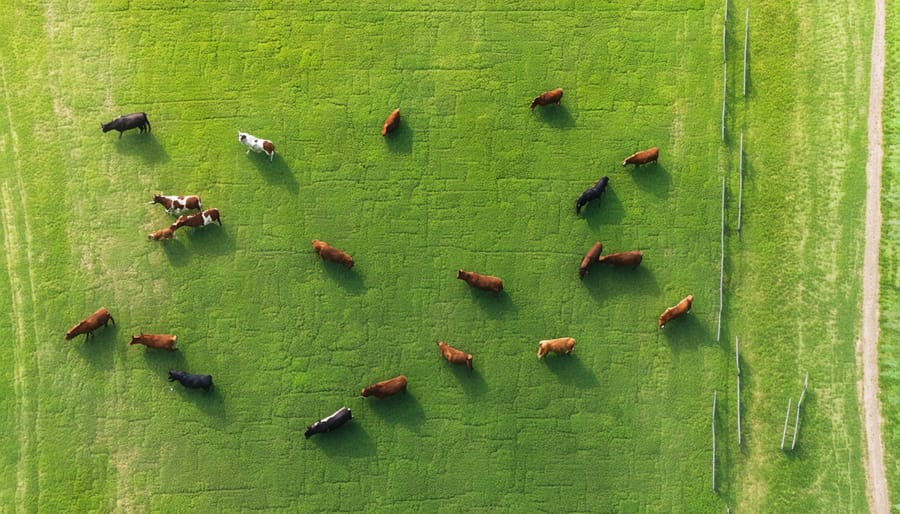
Manure Management Best Practices
Effective manure management plays a crucial role in reducing greenhouse gas emissions from livestock operations while maintaining soil health. Here in Alberta, many farmers have successfully implemented innovative approaches that benefit both the environment and their bottom line.
Composting is a cornerstone practice that transforms raw manure into stable organic matter. When properly managed, composting can reduce methane emissions by up to 50% compared to traditional stockpiling. The key is maintaining proper aeration and moisture levels – aim for 50-60% moisture content and turn piles regularly to prevent anaerobic conditions.
Cover your manure storage areas to prevent excess moisture and reduce nitrogen loss through volatilization. Using heavy-duty tarps or permanent structures helps control the decomposition process and minimizes ammonia emissions. Several Alberta farmers have reported significant improvements in nutrient retention using this method.
Consider implementing a rotational schedule for manure spreading that aligns with crop needs and soil conditions. Spring and early summer applications typically result in better nutrient uptake and lower emission rates. Using low-emission spreading techniques, such as injection or immediate incorporation, can reduce ammonia losses by up to 90%.
Installing solid-liquid separation systems helps manage different manure streams more effectively. The solid portion can be composted, while the liquid fraction can be used for precision irrigation. This approach has shown promising results at several dairy operations across central Alberta, reducing both emissions and operational costs.
Regular soil testing and maintaining detailed records of manure application rates helps optimize nutrient management and prevents over-application, which can lead to increased nitrous oxide emissions.
Success Stories from Alberta’s Organic Farms
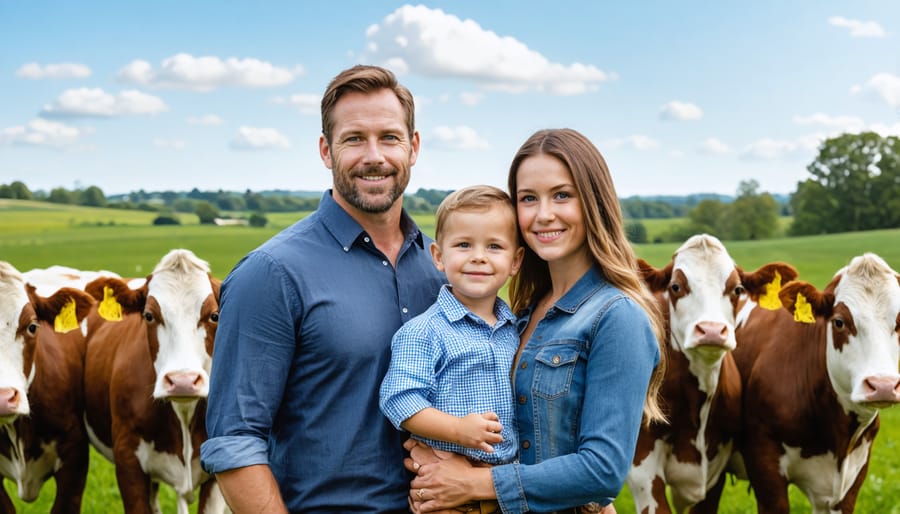
The Wilson Family’s Dairy Operation
Located just outside of Red Deer, Alberta, the Wilson Family Dairy has become a leading example of how Canadian farms can successfully reduce greenhouse gas emissions while maintaining profitable operations. Over the past five years, the Wilson family has implemented a series of innovative practices that have cut their farm’s emissions by 35% while increasing milk production by 12%.
The turning point came in 2018 when Sarah Wilson, the third-generation farmer, partnered with local agricultural experts to conduct a comprehensive emissions audit. The results showed that feed fermentation and manure management were their biggest sources of methane emissions.
In response, the Wilsons adopted a precision feeding program that optimizes nutrient intake for their 200-head dairy herd. They installed an anaerobic digester to capture methane from manure and convert it into renewable energy, which now powers 60% of their farm operations. The family also implemented rotational grazing practices and planted shelter belts of native trees around their property.
“The key was taking small, manageable steps,” explains Sarah Wilson. “We didn’t transform everything overnight. Each change was carefully planned and implemented with our farm’s long-term sustainability in mind.”
The Wilsons’ success has inspired neighboring farms to adopt similar practices, creating a ripple effect throughout central Alberta’s dairy community. Their farm regularly hosts workshops for other farmers interested in emission reduction strategies.
Mountain View Beef: A Carbon-Smart Approach
Located in the rolling foothills of southern Alberta, Mountain View Beef demonstrates how innovative management practices can significantly reduce greenhouse gas emissions while maintaining profitable cattle operations. Ranch owner Sarah Thompson implemented a comprehensive carbon-smart approach in 2018, which has since become a model for sustainable beef production in Western Canada.
The ranch employs rotational grazing across its 2,000 hectares, moving cattle every three to five days through carefully managed paddocks. This practice has improved soil carbon sequestration by an estimated 2.5 tonnes per hectare annually. Thompson also introduced diverse cover crops, including deep-rooted species like alfalfa and clover, which enhance soil structure while providing high-quality feed.
“We’ve seen a 30% reduction in our methane emissions since implementing these changes,” Thompson explains. “The key was finding solutions that benefit both the environment and our bottom line.” The ranch’s innovative feed management program includes locally sourced feed additives that reduce enteric methane production.
Mountain View’s success also stems from its partnership with local agricultural researchers. Through ongoing soil testing and emissions monitoring, the ranch continuously refines its practices. The operation has maintained its productivity while reducing its carbon footprint, proving that environmental stewardship and profitable farming can go hand in hand.
Other Alberta ranchers are now adopting similar practices, creating a growing network of carbon-conscious beef producers in the region.
Implementation Guide for Your Farm
Getting Started: First Steps
Getting started with emission reduction doesn’t have to be overwhelming. The key is to begin with simple, manageable steps that can make a meaningful impact. Start by conducting a basic emissions audit of your farm operations, focusing on areas like feed management, manure handling, and energy usage. This baseline assessment will help you identify where the biggest opportunities for improvement lie.
One of the most effective first steps is implementing climate-smart farming practices that align with your existing operations. Consider rotational grazing, which not only helps reduce emissions but also improves soil health and pasture productivity. Many Alberta farmers have found success by dividing their pastures into smaller paddocks and moving livestock more frequently.
Next, look at your feed efficiency. Simple adjustments to feeding schedules and ration composition can significantly reduce methane emissions while potentially improving animal performance. Start tracking feed conversion rates and work with a local nutritionist to optimize your feeding program.
Document your current practices and set realistic goals for improvement. Many farmers find it helpful to join local agricultural networks or discussion groups where they can share experiences and learn from others who are also working to reduce their environmental impact. Remember, even small changes can lead to significant results when implemented consistently over time.
Available Support and Resources
Canadian farmers looking to reduce their livestock greenhouse gas emissions have access to numerous support programs and resources. The Canadian Agricultural Partnership (CAP) offers funding opportunities specifically designed for environmental stewardship initiatives, including projects focused on reducing methane emissions from livestock operations.
In Alberta, the Environmental Stewardship and Climate Change Producer Program provides grants of up to $100,000 for implementing emission reduction practices. The Agricultural Research and Extension Council of Alberta (ARECA) offers technical support and workshops focusing on sustainable livestock management practices.
Farmers can access expert guidance through Agriculture and Agri-Food Canada’s regional offices, which provide free consultations with agricultural specialists. The Alberta Farm Sustainability Extension Working Group (AFSEWG) offers peer-to-peer learning opportunities and demonstration farm visits.
Financial assistance is available through the Canadian Agricultural Loans Act (CALA) program, which helps farmers secure loans for equipment upgrades and infrastructure improvements related to emission reduction. Additionally, the Scientific Research and Experimental Development (SR&ED) tax incentive program supports farmers implementing innovative emission reduction solutions.
Local agricultural societies and farmer-led research groups regularly organize workshops and field days, providing hands-on learning opportunities. The Farm Energy and Agri-Processing Program offers rebates for energy-efficient equipment upgrades, while the Environmental Farm Plan program helps farmers assess their environmental impact and access related funding opportunities.
As Alberta’s farming community, we have both the responsibility and opportunity to lead the way in reducing greenhouse gas emissions from livestock operations. The strategies we’ve explored – from improved feed management to rotational grazing and manure handling – demonstrate that environmental stewardship and profitable farming can go hand in hand. By implementing these practices, we not only contribute to Canada’s climate goals but also build more resilient and sustainable farm operations for future generations. Remember, every small change matters, and together, our collective efforts can make a significant impact. Consider starting with one or two practices that best suit your operation, and connect with local agricultural extension services for support in making these positive changes. Your actions today help secure a stronger, more sustainable future for Canadian agriculture.

